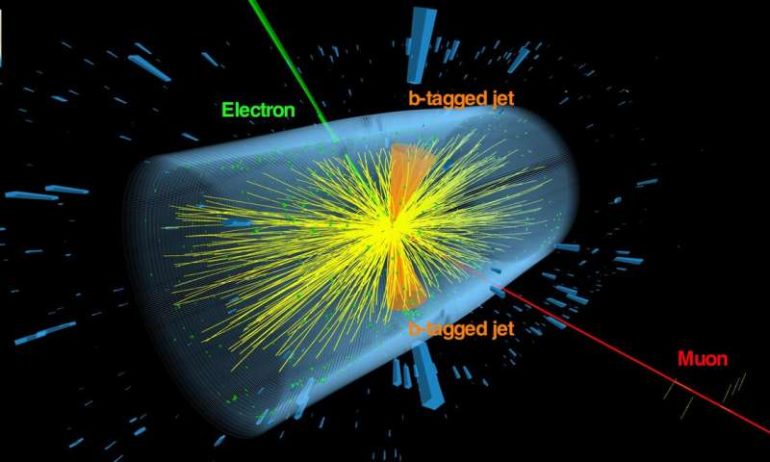The result of recent research by the CMS collaboration opens the path to study in a new and unique way an extreme state of matter that is thought to have existed shortly after the Big Bang. The collaboration has seen evidence of top quarks in collisions between heavy nuclei at the Large Hadron Collider (LHC).
This isn’t the first time this special particle—the heaviest known elementary particle—has made an appearance at particle colliders. The top quark was first observed in proton–antiproton collisions at the Tevatron collider 25 years ago, and has since been spotted and studied in proton–proton and proton–nucleus collisions at the LHC. But the new finding, described in a paper just accepted for publication in Physical Review Letters, is sure to excite experimentalists and theorists alike, for analysis of top quarks in heavy-nuclei collisions offers a new and unique way to study the quark–gluon plasma that forms in these collisions and is thought to have existed in the early moments of the universe. In addition, such analysis could cast new light on the arrangement of quarks and gluons inside heavy nuclei.
There isn’t exactly a shortage of particles, or probes, with which to investigate the quark–gluon plasma. The LHC experiments have long been using several types of particle to study the properties of this extreme state of matter, in which quarks and gluons are not confined within composite particles but instead roam like particles in a liquid with small frictional resistance. But all of the existing probes provide time-averaged information about the plasma. By contrast, the top quark, owing to the particular way in which it transforms, or decays into other particles, can provide snapshots of the plasma at different times of its lifetime.
“Faster-moving top quarks provide later-time snapshots. By assembling snapshots taken with top quarks at a range of different speeds, we hope that it will eventually be possible to create a movie of the quark–gluon plasma’s evolution,” explains CERN-based researcher Guilherme Milhano, who co-authored a theoretical study on probing the quark–gluon plasma with top quarks. “The new CMS result represents the very first step down that road.”
The CMS collaboration saw evidence of top quarks in a large data sample from lead–lead collisions at an energy of 5.02 TeV. The team searched for collisions producing a top quark and a top antiquark. These quarks decay very quickly into a W boson and a bottom quark, which in turn also decay very rapidly into other particles. The CMS physicists looked for the particular case in which the final decay products are charged leptons (electrons or their heavier cousins muons) and ‘jets’ of multiple particles originating from bottom quarks.
After isolating and counting these top–antitop collision events, CMS estimated the probability for lead–lead collisions to produce top–antitop pairs via charged leptons and bottom quarks. The result has a statistical significance of about four standard deviations, so it doesn’t yet cross the threshold of five standard deviations that is required to claim observation of top-quark production. But it represents significant evidence of the process—there’s only a 0.003% chance that the result is a statistical fluke. What’s more, the result is consistent with theoretical predictions, as well as with extrapolations from previous measurements of the probability in proton–proton collisions at the same collision energy.
“Our result demonstrates the capability of the CMS experiment to perform top-quark studies in the complex environment of heavy-nuclei collisions,” says CMS physicist Georgios Krintiras, a postdoctoral researcher at the University of Kansas, “and it’s the first stepping stone in using the top quark as a new and powerful probe of the quark–gluon plasma.”
The first evidence of vector meson spin alignment in heavy-ion collisions
More information:
A. M. Sirunyan et al. Evidence for top quark production in nucleus-nucleus collisions. Phys. Rev. Lett. (2020)
journals.aps.org/prl/accepted/ … 6863814716f152636202
On Arxiv: arxiv.org/abs/2006.11110
Citation:
Evidence of top quarks in collisions between heavy nuclei (2020, October 9)
retrieved 10 October 2020
from https://phys.org/news/2020-10-evidence-quarks-collisions-heavy-nuclei.html
This document is subject to copyright. Apart from any fair dealing for the purpose of private study or research, no
part may be reproduced without the written permission. The content is provided for information purposes only.


